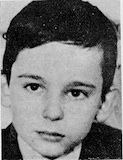
By Eamonn McCann (for the Derry Journal)
The Saville Report devotes more space to Gerald Donaghey - 17 years-old when shot dead on Bloody Sunday - than to any other individual.
Twenty-one chapters (Volume Seven, 125 to 145) are given over to examining whether Gerald had nail bombs in his pockets when his body arrived at an Army station on Foyle Road.
The Tribunal concluded that he “probably” did have the bombs in his pockets. However, it goes on to say: “Gerald Donaghey was not shot because of his possession of nail bombs...He was, in our view...shot by Private G who neither had, nor believed that he had, any justification for firing the shot...It is likely that Gerald Donaghey was trying to escape from the soldiers when he was shot.”
So Gerald was as fully exonerated as any of the other victims. Nevertheless, from the point of view of the families, the Tribunal’s finding that he had probably been carrying nail bombs was the only cloud on the day and is a continuing source of distress to Gerald’s relatives.
Gerry was shot in the back as he fled across the shallow steps at Abbey Park. He was carried into the home of local community leader Raymond Rogan where he was examined by Dr. Kevin Swords. The doctor urged that he be taken to hospital immediately. Rogan and Leo Young carried the mortally-wounded youngster to Rogan’s car, laid him on the back seat and set off.
The car was stopped at Barrier 20 in Barrack Street. Rogan and Young were arrested. A soldier then drove the car to “Bridge Camp” on Foyle Road beside Craigavon Bridge. It was here that four nail bombs were found, two in the breast pockets of his denim jacket, two in his jeans pockets.
The question is: how did they get there?
The Report observes that, if the bombs had been planted, this must have happened at Bridge Camp and that, therefore, someone must have been waiting there with the bombs prepared prior to the car arriving - highly unlikely, the Report suggests.
On the other hand, there is compelling evidence that the bombs were not in Gerald’s pockets when his body left Rogan’s house.
Raymond Rogan remembers it like yesterday and can point to where Gerald’s body was laid on the living room sofa. He says that, if there had there been nail bombs in the pockets, he would certainly have seen them. One weighed one pound two ounces, one weighed one pound five ounces, the third was one pound eight ounces, the last two pounds two ounces. Almost half a stone of nails and explosives in the pockets of tight-fitting denims.
Leo Young says that he searched Gerald for identification, putting his hands into his pockets. Dr. Swords “felt over the whole of (Gerald’s) body”. Donnacha Mac Ficheallaigh and Patsy Bradley also tended to Gerald. None noticed nail-bombs.
Dr. Swords said: “If he had any bulky objects in his pockets, I could not have missed it.” But Captain 127 testified that, when he looked at Gerald’s body in the back of the car at Bridge Camp, the bombs were “clear and plain to see. Anyone with normal eyesight would not have missed it.”
The contradiction would appear to be irresolvable. But the Tribunal came down on one side: “In the end, we have concluded that the difficulties with the possibility that the nail bombs were planted at the Bridge Camp outweigh the difficulties with the possibility that they were in Gerald Donaghey’s pockets when he was shot. Since to our minds these are on the evidence the only two viable possibilities, it follows on this basis that, in our view, Gerald Donaghey was probably in possession of the nail bombs when he was shot.”
The Report bases this finding on a theory that, in the terror and turmoil of the moment, Raymond Rogan, Leo Young, Dr. Swords and others didn’t notice something which in calmer circumstances they couldn’t have missed.
But nowhere in the 21 chapters does the Tribunal, in weighing up the theory that the bombs were planted, factor in the pattern of perjury, concealment and cover-up which hall-marked the military evidence in relation to other aspects of the day.
If the evidence establishes beyond reasonable doubt that the bombs were not in Gerald’s pockets when his body left Rogan’s house but were on his body when or shortly after it reached Bridge Camp, then they must have been planted.
The Tribunal might reasonably have concluded that the evidence on the issue was so inconsistent and riven by contradiction that no finding was possible. Instead, they gave the benefit of the doubt to the soldiers.
It’s almost as if the judges, in finding, as they had to, that all the dead and wounded were innocent, reckoned, possibly sub-consciously, that they had to throw a bone to the other side. And Gerry Donaghey fitted the bill.
![[Irish Republican News]](https://republican-news.org/graphics/title_gifs/rn.gif)
![[Irish Republican News]](https://republican-news.org/graphics/title_gifs/harp.gif)

